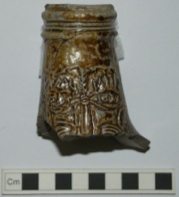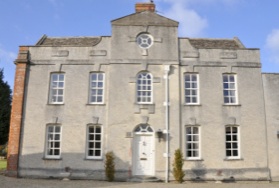An Outline History of Stanford in the Vale
|
 |
|
|
|
|
 |
| |
 |
|
|
|
|
 |
| |
 |
|
|
|
|
 |
Early Modern Stanford
The Civil War gave way to the Commonwealth, and the Commonwealth to the Restoration. The Churchwardens' Accounts note payments for blotting out the King's Arms and setting up the State's Arms in 1652, then for setting up the King's Arms again in 1660.
 Life continued in Stanford much as before. Drovers would have driven their flocks of sheep to market at Ilsley. Quakers (the Society of Friends) were present in Stanford and Goosey between 1665 and 1702, according to the Churchwarden's Accounts and the Bishops' Visitations of 1671, 1683 and 1695. Individuals mentioned for not coming to church, for not baptising their children and for not paying their taxes towards the repair of the church (although not necessarily all Quakers) included John Ge (a/r)ring, Thomas Langley, Clement Kent, John Shilton, Daniel Bunce (of Goosey), John Pinnell, and their wives (who probably had a great deal more equality than the woman-folk of their conformist brethren). Some of the names appear in minute books of Quaker meetings, which were held at West Challow, Faringdon, Goosey, Charney Bassett and elsewhere.
Life continued in Stanford much as before. Drovers would have driven their flocks of sheep to market at Ilsley. Quakers (the Society of Friends) were present in Stanford and Goosey between 1665 and 1702, according to the Churchwarden's Accounts and the Bishops' Visitations of 1671, 1683 and 1695. Individuals mentioned for not coming to church, for not baptising their children and for not paying their taxes towards the repair of the church (although not necessarily all Quakers) included John Ge (a/r)ring, Thomas Langley, Clement Kent, John Shilton, Daniel Bunce (of Goosey), John Pinnell, and their wives (who probably had a great deal more equality than the woman-folk of their conformist brethren). Some of the names appear in minute books of Quaker meetings, which were held at West Challow, Faringdon, Goosey, Charney Bassett and elsewhere.
The Compton Census of 1676 notes 245 Conformists, 15 Nonconformists and no 'Papists' as being present in Stanford in the Vale, a situation similar to other local parishes; compared with returns from Buckland, which indicated that it had 666 Conformists, 2 Nonconformists and 32 Papists. From late May to early August of 1646, Stanford was hit by plague. During this period 33 men, women and children from the village died. The church plate includes a flagon given by 'Joseph Cox, Esq and Kathie Sophia his wife as a humble testimony of their unfeigned thanks to Almighty God for the recovery of their three small children from the smallpox by inoculation, anno 1752', i.e. 44 years before Edward Jenner's development of a vaccination against smallpox using cowpox pustule exudate.
 In 1690 the Cox family constructed one of the grand and substantial houses of the village, Cox’s Hall and its adjacent Dovecote. At the time Cox’s Hall was of a larger and more impressive construction with Eastern and Western wings as well as the central frontage which exists to this day. From the examination of historical maps, it has been shown that the western wing of the house was demolished at some point between 1890 and 1910. Recent archaeological works have suggested that a major fire may have been the cause of the demolition as evidence of burning at high temperatures was identified on excavated plaster and brickwork from the demolition of the structure. From the archaeological works, it was also shown that once the demolition works were completed, the area was laid out as formal gardens to blend in with the rest of the grounds.
In 1690 the Cox family constructed one of the grand and substantial houses of the village, Cox’s Hall and its adjacent Dovecote. At the time Cox’s Hall was of a larger and more impressive construction with Eastern and Western wings as well as the central frontage which exists to this day. From the examination of historical maps, it has been shown that the western wing of the house was demolished at some point between 1890 and 1910. Recent archaeological works have suggested that a major fire may have been the cause of the demolition as evidence of burning at high temperatures was identified on excavated plaster and brickwork from the demolition of the structure. From the archaeological works, it was also shown that once the demolition works were completed, the area was laid out as formal gardens to blend in with the rest of the grounds.
The increase in wheeled traffic and the deterioration of roads and bridges created a need for improvements in the communication routes, and thus the turnpike system began. The first improvements were in roads leading towards London through the Thames Valley, and subsequent the roads north-south. Following routes from Faringdon to Lechlade and Fairford (1726) and Faringdon to Fyfield (1733), the Faringdon, Wantage and Wallingford Road came into the turnpike system in 1752. In 1756, the Faringdon to Cricklade and Malmsbury Road came into the turnpike system, and roads from Wantage to Besselsleigh, and Faringdon to Burford came under the system in 1770 and 1771, respectively. The section between Faringdon and Wantage was completed soon after the Act of Parliament established the Trust for the Wallingford, Wantage & Faringdon Turnpike, with a toll gate first on Stanford Mill Bridge, with a smaller check gate across Park Lane known as Challow Toll Gate, and later on the main road at the junction of Baulking Lane.
A better route was now established for trade with London and other economic centres. The demands of profitable production of food gave more profit to the landowners, often at the expense of the poor. Enclosures of common land had been undertaken since medieval times, but there was a surge in enclosures in the 18th C and, in turn, an enclosure award covering Stanford in 1784. The industrial revolution largely bypassed Stanford, but a windmill appeared in the village (Bow Road), and was illustrated by John Stone in 1794, as well as a productive brickworks at Bow, long associated with the Puzey family, including, most recently, John Witfield Puzey, brick tile and drainpipe manufacturer, who appeared in directories of 1891-1928.
|